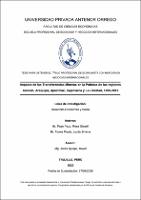| dc.contributor.advisor | Jaulis Quispe, David | |
| dc.contributor.author | Pazo Pazo, Rosa Gissell | |
| dc.contributor.author | Torres Prado, Lucila Jimena | |
| dc.creator | Pazo Pazo, Rosa Gissell | |
| dc.date.accessioned | 2020-10-28T21:49:57Z | |
| dc.date.available | 2020-10-28T21:49:57Z | |
| dc.date.issued | 2020 | |
| dc.identifier.uri | https://hdl.handle.net/20.500.12759/6689 | |
| dc.description.abstract | Una de las principales actividades económicas para el país es la minería,
ya que a nivel macroeconómico ha tenido mejores oportunidades de crecimiento;
pero a nivel local, la realidad de las zonas en donde se practica esta actividad es
preocupante y se ve reflejado en el porcentaje de incidencia de pobreza en
donde esta se realiza.
La presente investigación tiene como objetivo determinar el impacto de
las transferencias mineras en la pobreza de las regiones de Ancash, Arequipa,
Apurímac, Cajamarca y La Libertad entre los años 1999-2019. Para ello, las
regiones de estudio fueron seleccionadas de acuerdo a las aportaciones que
reciben a nivel nacional, separando a las principales regiones con mayores
transferencias y de las que no, además de su aporte significativo al PBI minero.
En el estudio, la variable pobreza fue determinada a través de un índice
conformado por: educación, expresado en la tasa de analfabetismo en personas
adultas, salud como la probabilidad de nacer y de no sobrevivir a los 40 años,
representado como la tasa de mortalidad infantil y el estándar de vida como
promedio no ponderado del porcentaje de pobladores sin acceso a agua potable
y tasa de niños con desnutrición. Con respecto a la variable transferencias
mineras será evaluado a través de las aportaciones por recurso minero como
son canon y regalía minera.
Para la verificación de la hipótesis, se estimó un modelo econométrico de
método mínimos cuadrados generalizados para los datos de tipo panel con
efectos fijos que permitió determinar las características propias de las regiones
de estudio y con ello el impacto que genera.
Finalmente, con el procesamiento de datos se concluyó que, por cada
aumento del canon minero en 1 millón de soles, la pobreza se ve reducida en
0.308% y por cada aumento de las regalías mineras en 1 millón de soles, la
pobreza se ve reducida en 1.6%, a pesar de los resultados el impacto fue mínimo
y esto se debió a las otras variables macroeconómicas y sociales que influyeron
en la pobreza, como la inflación, tipo de cambio, producto bruto interno (PBI),
índice de desarrollo humano (IDH) y conflictos sociales | es_PE |
| dc.description.abstract | One of the main economic activities for the country is mining, since a
macroeconomic level has led us to growth opportunities; but at the local level,
that of the areas where this activity is practiced is worrying and is reflected in the
percentage of incidence of poverty where it is carried out.
This research aims to determine the impact of mining transfers on poverty
in the regions of Ancash, Arequipa, Apurímac, Cajamarca and La Libertad
between the years 1999-2019. To this end, the study regions were selected
according to the contributions they receive at the national level, separating the
main regions with larger transfers and those that do not, in addition to their
significant contribution to mining GDP.
In the study, the poverty variable was determined through an index made
up of: education, expressed in the illiteracy rate in people over 15 years of age,
health as the probability of being born and dying, represented as the infant
mortality rate and the standard of living as a percentage of inhabitants without
access to drinking water and the rate of children with malnutrition. With respect
to variable mining transfers, it will be evaluated through contributions per mining
resource such as canon and mining royalty.
To verify the hypothesis, an economic model of generalized least squares
method was estimated for the fixed effects panel type data that will determine the
characteristics of the study regions and thus the impact it generates.
Finally, with the data processing it was concluded that, for each increase
in the mining canon by 1 million soles, poverty is reduced by 0.308% and for each
increase in mining royalties by 1 million soles, poverty is reduced at 1.6%, despite
the results, the impact was minimal and this was due to the other macroeconomic
and social variables that influenced poverty, such as inflation, exchange rate,
gross domestic product (GDP), human development index ( HDI) and social
conflicts. | en_US |
| dc.description.uri | Tesis | es_PE |
| dc.format | application/pdf | es_PE |
| dc.language.iso | spa | es_PE |
| dc.publisher | Universidad Privada Antenor Orrego | es_PE |
| dc.relation.ispartofseries | T_ECON_112 | |
| dc.rights | info:eu-repo/semantics/openAccess | es_PE |
| dc.rights.uri | https://creativecommons.org/licenses/by/4.0/ | es_PE |
| dc.source | Universidad Privada Antenor Orrego | es_PE |
| dc.source | Repositorio Institucional - UPAO | es_PE |
| dc.subject | Pobreza | es_PE |
| dc.subject | Regiones Mineras | es_PE |
| dc.title | Impacto de las transferencias mineras en la pobreza de las regiones Áncash, Arequipa, Apurímac, Cajamarca y la libertad, 1999 - 2019 | es_PE |
| dc.type | info:eu-repo/semantics/bachelorThesis | es_PE |
| thesis.degree.level | Título Profesional | es_PE |
| thesis.degree.grantor | Universidad Privada Antenor Orrego. Facultad de Ciencias Económicas | es_PE |
| thesis.degree.name | Economista con Mención en Negocios Internacionales | es_PE |
| thesis.degree.discipline | Economía | es_PE |
| dc.subject.ocde | https://purl.org/pe-repo/ocde/ford#5.02.01 | es_PE |
| renati.type | https://purl.org/pe-repo/renati/type#tesis | es_PE |
| renati.level | https://purl.org/pe-repo/renati/level#tituloProfesional | es_PE |
| dc.publisher.country | PE | es_PE |


